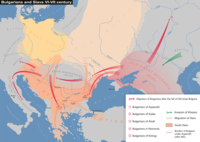History of Bulgaria
This article's lead section may be too long. (September 2023) |
| History of Bulgaria |
|---|
 |
|
|
|
Main category |
The history of Bulgaria can be traced from the first settlements on the lands of
Meanwhile, in 632 the
In the 11th century, the First Bulgarian Empire collapsed under multiple Rus' and Byzantine attacks and wars, and was conquered and became part of the Byzantine Empire until 1185. Then, a major uprising led by two brothers, Asen and Peter of the Asen dynasty, restored the Bulgarian state to form the Second Bulgarian Empire. After reaching its apogee in the 1230s, Bulgaria started to decline due to a number of factors, most notably its geographic position which rendered it vulnerable to simultaneous attacks and invasions from many sides. A peasant rebellion, one of the few successful such in history, established the swineherd Ivaylo as a Tsar. His short reign was essential in recovering—at least partially—the integrity of the Bulgarian state. A relatively thriving period followed after 1300, but ended in 1371, when factional divisions caused Bulgaria to split into three small Tsardoms. By 1396, they were subjugated by the Ottoman Empire. The Turks eliminated the Bulgarian system of nobility and ruling clergy, and Bulgaria remained an integral Ottoman Empire territory for the next 500 years.
With the decline of the Ottoman Empire after 1700, signs of revival started to emerge. The Bulgarian nobility had vanished, leaving an egalitarian peasant society with a small but growing urban middle class. By the 19th century, the
After World War II, Bulgaria became a Communist state, and the General Secretary of the Bulgarian Communist Party, Todor Zhivkov, served for a period of 35 years, where there was relatively rapid economic growth. The Communist system collapsed in the 1980s, and several problems in the 1990s decreased the economic development of Bulgaria's agricultural and other industries. A period of relative stabilization began with the election of Simeon Saxe-Coburg-Gotha as prime minister in 2001. Bulgaria joined NATO in 2004 and the European Union in 2007.
Prehistory


The earliest human remains found in Bulgaria were excavated in the
The earliest dwellings in Bulgaria – the
The
Some of the earliest evidence of grape cultivation and livestock domestication is associated with the Bronze Age Ezero culture.[14] The Magura Cave drawings date from the same era, although the exact years of their creation cannot be pin-pointed.
Antiquity
The Thracians


The first people to leave lasting traces and cultural heritage throughout the region were the Thracians. Their origin remains obscure. It is generally proposed that a proto-Thracian people developed from a mixture of indigenous peoples and Indo-Europeans from the time of Proto-Indo-European expansion in the Early Bronze Age[15] when the latter, around 1500 BC, conquered the indigenous peoples.[16] Thracian craftsmen inherited the skills of the indigenous civilisations before them, especially in gold working.[17]
The Thracians were generally disorganized, but had an advanced culture despite the lack of their own proper script, and gathered powerful military forces when their divided tribes formed unions under the pressure of external threats. They formed the
The first
Achaemenid Persian invasions

Ever since the
Thracian Odrysian kingdom (c. 480 BC - 30 BC)
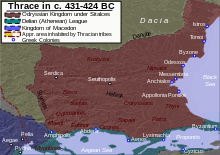
Thracian tribes remained divided and most of them fell under nominal Persian rule from the late 6th century until the first half of the 5th century,
Ancient Macedon invasions
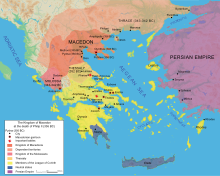
Thereafter the
Ancient Celtic invasions

In 298 BC,
In 279 BC, one of the Celtic armies, led by Comontorius, attacked Thrace and succeeded in conquering it. Comontorius established the kingdom of Tylis in what is now eastern Bulgaria.[31] The modern-day village of Tulovo bears the name of the relatively short-lived kingdom. Cultural interactions between Thracians and Celts are evidenced by several items containing elements of both cultures, such as the chariot of Mezek and almost certainly the Gundestrup cauldron.[32]
Tylis lasted until 212 BC, when the Thracians managed to regain their dominant position in the region and disbanded it.[33] Small bands of Celts survived in Western Bulgaria. One such tribe were the serdi, from which Serdica - the ancient name of Sofia - originates.[34] Even though the Celts remained in the Balkans for more than a century, their influence on the peninsula was modest.[31] By the end of the 3rd century, a new threat appeared for the people of the Thracian region in the shape of the Roman Empire.
Roman period
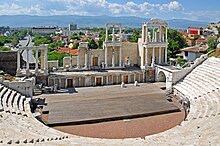
In 188 BC, the Romans invaded Thrace, and warfare continued until 46 AD when Rome finally conquered the region.
Sapaean Thracian kingdom (Roman vassal state) (1st century BC - 46 AD)
The
Roman rule
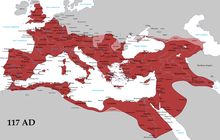
In 46 AD, the Romans established the
Migration Period (3rd century - 7th century)

In the 4th century, a group of
Due to the rural nature of the local population, Roman control of the region remained weak. In the 5th century,
During the 6th century, the traditional Greco-Roman culture was still influential, but Christian philosophy and culture were dominant and began to replace it.
-
Gothic Invasions 250–251
-
Gothic Invasions 267–269
-
Gothic Invasions 376–382
-
The Bulgar and Slavic migrations 6th - 7th century
Slavs
The Slavs emerged from their original homeland (most commonly thought to have been in Eastern Europe) in the early 6th century and spread to most of eastern Central Europe, Eastern Europe and the Balkans, thus forming three main branches - the West Slavs, the East Slavs and the South Slavs. The easternmost South Slavs settled on the territory of modern Bulgaria during the 6th century.
Most of the Thracians were eventually Hellenized or Romanized, with some exceptions surviving in remote areas until the 5th century.[40][41] A portion of the eastern South Slavs assimilated most of them, before the Bulgar élite incorporated these peoples into the First Bulgarian Empire.[42]
Bulgars
The Bulgars were a semi-nomadic people of
Old Great Bulgaria
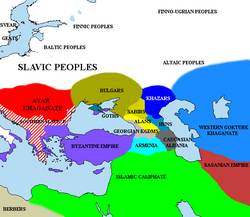
Unified under a single ruler, Kurt, or Kubrat (reigned c. 605–c. 642), the Bulgars constituted a powerful polity known to the Eastern Romans as
In 635, Kubrat signed a peace treaty with emperor Heraclius of the Byzantine Empire, expanding the Bulgar kingdom further into the Balkans. Later, Kubrat was crowned with the title Patrician by Heraclius. The kingdom never survived Kubrat's death. After several wars with the Khazars, the Bulgars were finally defeated and they migrated to the south, to the north, and mainly to the west into the Balkans, where most of the other Bulgar tribes were living, in a state vassal to the Byzantine Empire since the 5th century.
One of the successors of Khan Kubrat, Kotrag led nine Bulgar tribes to the north along the banks of the river Volga in what is today Russia, creating the Kingdom of the Volga Bulgars in the late 7th century. This kingdom later became the trade and cultural centre of the north, because it stood on a very strategic position creating a monopoly over the trade among the Arabs, the Norse and the Avars. The Volga Bulgars were the first to ever defeat the Mongolic horde and protected Europe for decades, but after countless Mongol invasions the Kingdom of the Volga Bulgars was destroyed and most of its citizens slaughtered or sold as slaves in Asia.
Another successor of Khan Kubrat,
Another Bulgar horde, led by Asparuh's brother Kuber, came to settle in Pannonia and later into the region of Macedonia.[44][45]
First Bulgarian Empire (681–1018)

Under the reign of
During the

The son and heir of Asparuh
Decades later, in 768,

Under the reign of
During the reign of Khan Omurtag (814–831), the northwestern boundaries with the Frankish Empire were firmly settled along the middle Danube. A magnificent palace, pagan temples, ruler's residence, fortress, citadel, water mains and baths were built in the Bulgarian capital Pliska, mainly of stone and brick.
Omurtag pursued policy of repression against Christians. Menologion of Basil II, glorifies Emperor Basil II showing him as a warrior defending Orthodox Christendom against the attacks of the Bulgarian Empire, whose attacks on Christians are graphically illustrated.
Christianization
Under Boris I, Bulgaria

In the early 9th century, a new alphabet —
By the late 9th and early 10th centuries, Bulgaria extended to Epirus and Thessaly in the south, Bosnia in the west and controlled all of present-day Romania and eastern Hungary to the north reuniting with old roots. A Serbian state came into existence as a dependency of the Bulgarian Empire. Under Tsar Simeon I of Bulgaria (Simeon the Great), who was educated in Constantinople, Bulgaria became again a serious threat to the Byzantine Empire. His aggressive policy was aimed at displacing Byzantium as major partner of the nomadic polities in the area. By subverting the principles of Byzantine diplomacy and political culture, Simeon turned his own kingdom into a society-structuring factor in the nomadic world.[48][49]
Simeon hoped to take Constantinople and become emperor of both
Bogomilism

During the reign of Emperor Peter I (r. 927–969) a
Decline
After Simeon's death, Bulgaria was weakened by external and internal wars with
In 986, the Byzantine emperor
Bulgaria under Byzantine rule (1018–1185)

No evidence remains of major resistance or any uprising of the Bulgarian population or nobility in the first decade after the establishment of
Basil II guaranteed the indivisibility of Bulgaria in its former geographic borders and did not officially abolish the local rule of the Bulgarian nobility, who became part of
After the death of Basil II the empire entered into a period of instability. In 1040,
In 1180 the last of the capable Komnenoi,
Second Bulgarian Empire (1185–1396)
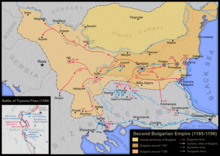


Resurrected Bulgaria occupied the territory between the
In the
The Bulgarian Orthodox
The country's military and economic might declined after the end of the Asen dynasty in 1257, facing internal conflicts, constant Byzantine and Hungarian attacks and Mongol domination.[42][66] Tsar Teodore Svetoslav (reigned 1300–1322) restored Bulgarian prestige from 1300 onwards, but only temporarily. Political instability continued to grow, and Bulgaria gradually began to lose territory. This led to a peasant rebellion led by the swineherd Ivaylo, who eventually managed to defeat the Tsar's forces and ascend the throne.
Ottoman incursions
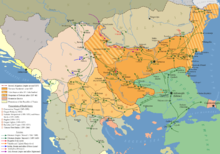
A weakened 14th-century Bulgaria faced a new threat from the south, the
The Ottomans faced little resistance from these divided and weak Bulgarian states. In 1362 they captured Philippopolis (
Bulgaria under Ottoman rule (1396–1878)
In 1393, the

The new authorities dismantled Bulgarian institutions and merged the separate
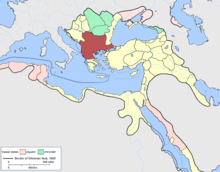
The Ottomans did not normally require the Christians to become Muslims. Nevertheless, there were many cases of forced individual or mass Islamization, especially in the
The Ottoman system began declining by the 17th century and at the end of the 18th had all but collapsed. Central government weakened over the decades and this had allowed a number of local Ottoman holders of large estates to establish personal ascendancy over separate regions.[70] During the last two decades of the 18th and first decades of the 19th centuries the Balkan Peninsula dissolved into virtual anarchy.[40][71]
Bulgarian tradition calls this period the kurdjaliistvo: armed bands of Turks called kurdjalii plagued the area. In many regions, thousands of peasants fled from the countryside either to local towns or (more commonly) to the hills or forests; some even fled beyond the Danube to Moldova, Wallachia or southern Russia.[40][71] The decline of Ottoman authorities also allowed a gradual revival of Bulgarian culture, which became a key component in the ideology of national liberation.

Conditions gradually improved in certain areas in the 19th century. Some towns — such as
Bulgarian nationalism was emergent in the early 19th century under the influence of western ideas such as liberalism and nationalism, which trickled into the country after the French Revolution, mostly via Greece. The Greek revolt against the Ottomans which began in 1821 also influenced the small Bulgarian educated class. But Greek influence was limited by the general Bulgarian resentment of Greek control of the Bulgarian Church and it was the struggle to revive an independent Bulgarian Church which first roused Bulgarian nationalist sentiment.
In 1870, a
April Uprising and Russo-Turkish War (1870s)


In April 1876, the Bulgarians revolted in the

The massacres aroused a broad public reaction among liberal Europeans such as
Turkey's refusal to implement the decisions of the conference gave Russia a long-waited chance to realise her long-term objectives with regard to the Ottoman Empire. Having its reputation at stake, Russia
Third Bulgarian State (1878–1946)

The
As a result, the
Alexander of Battenberg, a German with close ties to the Russian Tsar, was the first prince (knyaz) of modern Bulgaria from 1879. Everyone had assumed Bulgaria would become a Russian ally. To the contrary, it became a bulwark against Russian expansion, and cooperated with the British.[76] Bulgaria was attacked by Serbia in 1885, but defeated the invaders. It thereby gained respect from the great powers and defied Russia. In response Russia secured the abdication of Prince Alexander in 1886.[77]
Stefan Stambolov (1854–1895) served 1886-1894 first as regent and then prime minister for the new ruler, Ferdinand I of Bulgaria (prince 1887–1908, tsar 1908–1918). Stambolov believed that Russia's liberation of Bulgaria from Turkish rule had been an attempt by Czarist Russia to turn Bulgaria into its protectorate. His policy was characterized by the goal of preserving Bulgarian independence at all costs, working with both the Liberal majority and Conservative minority parties. During his leadership Bulgaria was transformed from an Ottoman province into a modern European state. Stambolov launched a new course in Bulgarian foreign policy, independent of the interests of any great power. His main foreign policy objective was the unification of the Bulgarian nation into a nation-state consisting of all the territories of the Bulgarian Exarchate granted by the Sultan in 1870. Stambolov established close connections with the Sultan in order to enliven Bulgarian national spirit in Macedonia and to oppose Russian-backed Greek and Serbian propaganda. As a result of Stambolov's tactics, the Sultan recognised Bulgarians as the predominant people in Macedonia and gave a green light to the creation of a strong church and cultural institutions. Stambolov negotiated loans with western European countries to develop the economic and military strength of Bulgaria. In part, this was motivated by his desire to create a modern army which could secure all of the national territory. His approach toward western Europe was one of diplomatic manoeuvring. He understood the interests of the Austrian Empire in Macedonia and warned his diplomats accordingly. His domestic policy was distinguished by the defeat of terrorist groups sponsored by Russia, the strengthening of the rule of law, and rapid economic and educational growth, leading to progressive social and cultural change, and development of a modern army capable of protecting Bulgaria's independence. Stambolov was aware that Bulgaria had to be politically, militarily, and economically strong to achieve national unification. He mapped out the political course which turned Bulgaria into a strong regional power, respected by the great powers of the day. However, Bulgaria's regional leadership was short-lived. After Stambolov's death the independent course of his policy was abandoned.[78]
Bulgaria emerged from Turkish rule as a poor, underdeveloped agricultural country, with little industry or tapped natural resources. Most of the land was owned by small farmers, with peasants comprising 80% of the population of 3.8 million in 1900. Agrarianism was the dominant political philosophy in the countryside, as the peasantry organized a movement independent of any existing party. In 1899, the Bulgarian Agrarian Union was formed, bringing together rural intellectuals such as teachers with ambitious peasants. It promoted modern farming practices, as well as elementary education.[79]
The government promoted modernization, with special emphasis on building a network of elementary and secondary schools. By 1910, there were 4,800 elementary schools, 330 lyceums, 27 post-secondary educational institutions, and 113 vocational schools. From 1878 to 1933, France funded numerous libraries, research institutes, and Catholic schools throughout Bulgaria. In 1888, a university was established. It was renamed the
The first decade of the century saw sustained prosperity, with steady urban growth. The capital of Sofia grew by a factor of 600% - from 20,000 population in 1878 to 120,000 in 1912, primarily from peasants who arrived from the villages to become laborers, tradesman and office seekers.
The Balkan Wars

In the years following independence, Bulgaria became increasingly militarized and was often referred to as "the Balkan
In February 1912 a secret treaty was signed between Bulgaria and Serbia and in May 1912 a similar agreement was sealed with Greece. Montenegro was also brought into the pact. The treaties provided for the partition of the regions of Macedonia and Thrace between the allies, although the lines of partition were left dangerously vague. After the Ottoman Empire refused to implement reforms in the disputed areas, the First Balkan War broke out in October 1912 at a time when the Ottomans were tied down in a major war with Italy in Libya. The allies easily defeated the Ottomans and seized most of its European territory.[85]
Bulgaria sustained the heaviest casualties of any of the allies while also making the largest territorial claims. The Serbs in particular did not agree and refused to vacate any of the territory they had seized in northern Macedonia (that is, the territory roughly corresponding to the modern
In June 1913, Serbia and Greece formed a new alliance against Bulgaria. The Serbian Prime Minister
The Serbian and Greek forces were initially beaten back from Bulgaria's western border, but they quickly gained the advantage and forced Bulgaria to retreat. The fighting was very harsh, with many casualties, especially during the key Battle of Bregalnitsa. Soon afterward, the Romania entered the war on the side of Greece and Serbia, attacking Bulgaria from the north. The Ottoman Empire saw this as an opportunity to regain its lost territories and also attacked from the south-east.
Facing war on three different fronts, Bulgaria sued for peace. It was forced to relinquish most of its territorial acquisitions in Macedonia to Serbia and Greece, Adrianapole to the Ottoman Empire, and the region of Southern Dobruja to Romania. The two Balkan wars greatly destabilized Bulgaria, stopping its hitherto steady economic growth, and leaving 58,000 dead and over 100,000 wounded. The bitterness at the perceived betrayal of its former allies empowered political movements who demanded the restoration of Macedonia to Bulgaria.[86]
World War I

In the aftermath of the Balkan Wars Bulgarian opinion turned against Russia and the Western powers, by whom the Bulgarians felt betrayed. The government of Vasil Radoslavov aligned Bulgaria with the German Empire and Austria-Hungary, even though this meant becoming an ally of the Ottomans, Bulgaria's traditional enemy. But Bulgaria now had no claims against the Ottomans, whereas Serbia, Greece and Romania (allies of Britain and France) held lands perceived in Bulgaria as Bulgarian.
Bulgaria sat out the first year of World War I recuperating from the Balkan Wars.[87] Germany and Austria realized they needed Bulgaria's help in order to defeat Serbia militarily thereby opening supply lines from Germany to Turkey and bolstering the Eastern Front against Russia. Bulgaria insisted on major territorial gains, especially Macedonia, which Austria was reluctant to grant until Berlin insisted. Bulgaria also negotiated with the Allies, who offered somewhat less generous terms. The Tsar decided to go with Germany and Austria and signed an alliance with them in September 1915, along with a special Bulgarian-Turkish arrangement. It envisioned that Bulgaria would dominate the Balkans after the war.[88]
Bulgaria, which had the land force in the Balkans, declared war on Serbia in October 1915. Britain, France and Italy responded by declaring war on Bulgaria. In alliance with Germany, Austria-Hungary and the Ottomans, Bulgaria won military victories against Serbia and Romania, occupying much of Macedonia (taking
However, the war soon became unpopular with most Bulgarians, who suffered great economic hardship and also disliked fighting their fellow Orthodox Christians in alliance with the Muslim Ottomans. The Russian Revolution of February 1917 had a great effect in Bulgaria, spreading anti-war and anti-monarchist sentiment among the troops and in the cities. In June Radoslavov's government resigned. Mutinies broke out in the army, Stamboliyski was released and a republic was proclaimed.
Interwar years
In September 1918, Tsar Ferdinand abdicated in favour of his son

Elections in March 1920 gave the Agrarians a large majority and Aleksandar Stamboliyski formed Bulgaria's first peasant government. He faced huge social problems, but succeeded in carrying out many reforms, although opposition from the middle and upper classes, the landlords and officers of the army remained powerful. In March 1923, Stamboliyski signed an agreement with the Kingdom of Yugoslavia recognising the new border and agreeing to suppress Internal Macedonian Revolutionary Organization (VMRO), which favoured a war to regain Macedonia from Yugoslavia.[93]
This triggered a nationalist reaction and
In May 1934
World War II
Upon the outbreak of World War II, the government of the Kingdom of Bulgaria under Bogdan Filov declared a position of neutrality, being determined to observe it until the end of the war, but hoping for bloodless territorial gains, especially in the lands with a significant Bulgarian population occupied by neighbouring countries after the Second Balkan War and World War I.[citation needed] But it was clear that the central geopolitical position of Bulgaria in the Balkans would inevitably lead to strong external pressure by both sides of World War II.[94] Turkey had a non-aggression pact with Bulgaria.[95]
Bulgaria succeeded in negotiating a recovery of

Bulgaria did not join the
On 23 August 1944, Romania left the Axis Powers and declared war on Germany, and allowed Soviet forces to cross its territory to reach Bulgaria. On 5 September 1944 the Soviet Union declared war on Bulgaria and invaded. Within three days, the Soviets occupied the northeastern part of Bulgaria along with the key port cities of Varna and Burgas. Meanwhile, on 5 of September, Bulgaria declared war on Nazi Germany. The Bulgarian Army was ordered to offer no resistance.[99]
On 9 September 1944 in a
People's Republic of Bulgaria (1946–1991)
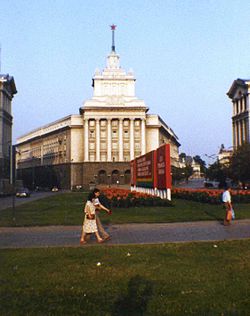
From 1946 to 1991 the country was known as the People's Republic of Bulgaria (PRB) and was ruled by the Bulgarian Communist Party (BCP). The BCP transformed itself in 1990, changing its name to "Bulgarian Socialist Party".
Communist leader
After 1944 he was also close to the
Bulgaria's Stalinist phase lasted less than five years. Under his leadership, agriculture was collectivised and a massive industrialisation campaign was launched. Bulgaria adopted a
Bulgaria experienced a rapid industrial development from the 1950s onwards. From the following decade, the country's economy appeared profoundly transformed. Although many difficulties remained, such as poor housing and inadequate urban infrastructure, modernisation was a reality. The country then turned to high technology, a sector which represented 14% of its GDP between 1985 and 1990. Its factories produce processors, hard disks, floppy disk drives and industrial robots.[105]
During the 1960s, Zhivkov initiated reforms and passed some market-oriented policies on an experimental level.
Republic of Bulgaria (since 1989)
By the time the impact of Mikhail Gorbachev's reform program in the Soviet Union was felt in Bulgaria in the late 1980s, the Communists, like their leader, had grown too feeble to resist the demand for change for long. In November 1989 demonstrations on ecological issues were staged in Sofia and these soon broadened into a general campaign for political reform. The Communists reacted by deposing Zhivkov and replacing him by Petar Mladenov, but this gained them only a short respite.
In February 1990 the Communist Party voluntarily gave up its monopoly on power and in June 1990 the first free elections since 1931 were held. The result was a return to power by the Communist Party, now shorn of its hardliner wing and renamed the Bulgarian Socialist Party. In July 1991 a new Constitution was adopted, in which the system of government was fixed as parliamentary republic with a directly elected President and a Prime Minister accountable to the legislature.
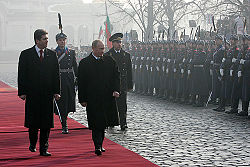
Like the other post-Communist regimes in Eastern Europe, Bulgaria found the transition to capitalism more painful than expected. The anti-Communist Union of Democratic Forces (UDF) took office and between 1992 and 1994 the Berov Government carried through the privatisation of land and industry through the issue of shares in government enterprises to all citizens, but these were accompanied by massive unemployment as uncompetitive industries failed and the backward state of Bulgaria's industry and infrastructure were revealed. The Socialists portrayed themselves as the defender of the poor against the excesses of the free market.
The negative reaction against economic reform allowed
On 17 June 2001,
Since 1989 Bulgaria has held multi-party
Bulgaria became a
See also
- Timeline of Bulgarian history
- Hominid dispersals in Europe
- Cradle of civilization
- Neolithic Revolution
- Neolithic Europe
- Thracians
- Moesi
- Getae
- List of ancient Daco-Thracian peoples and tribes
- Dacians
- Paeonia (kingdom)
- Scythians
- Classical Antiquity
- Timeline of Varna
- Philippopolis (Thrace)
- Celtic settlement of Southeast Europe
- List of archaeological sites by country
- History of Sofia
- Edict of Serdica
- Ancient Roman architecture
- Early centers of Christianity
- List of oldest known surviving buildings
- List of oldest church buildings
- Fresco
- Migration Period
- Gothic Bible
- Bulgarian Empire
- Golden Age of medieval Bulgarian culture
- Early Cyrillic alphabet
- Balkan–Danubian culture
- Bulgarian–Latin wars
- Tsarevets (fortress)
- Architecture of the Tarnovo Artistic School
- Tarnovo Literary School
- Baba Vida
- Byzantine–Bulgarian wars
- National awakening of Bulgaria
- Bulgarian unification
- List of Bulgarian monarchs
- Medieval Bulgarian army
- Medieval Bulgarian navy
- Bulgarian lands across the Danube
- Bulgarian language
- Bulgarian dialects
- List of predecessors of sovereign states in Europe
- List of sovereign states by date of formation § Europe
- List of empires
- List of medieval great powers
- List of oldest continuously inhabited cities
- History of the Balkans
- History of the Mediterranean region
- History of Europe
- History of the European Union
References
- ^ "Sirakov et al. (2010).- an ancient continuous human presence in the Balkans and the beginnings of human settlement in western Eurasia: A Lower Pleistocene example of the Lower Palaeolithic levels in Kozarnika cave (North-western Bulgaria) | Philippe Fernandez - Academia.edu". academia.edu. Archived from the original on 25 December 2014. Retrieved 2 February 2022.
- ^ ISBN 978-1-4443-5163-7pp 135–138, pp 343–345
- ISBN 9780191605048. Retrieved 24 December 2014.
- ^ Runciman, p. 26
- ^ Bulgaria - Introduction, Library of Congress
- ISBN 0822339382. Retrieved 11 November 2011.
- ^ The Neolithic Dwellings Archived 2011-11-28 at the Wayback Machine at the Stara Zagora Neolithic Dwellings Museum website
- ^ Slavchev, Vladimir (2004–2005). Monuments of the final phase of Cultures Hamangia and Savia on the territory of Bulgaria (PDF). Vol. 37–38. pp. 9–20. Archived (PDF) from the original on 2011-07-18.
{{cite book}}:|work=ignored (help) - ISBN 978-0-415-15803-9.
- ^ Squires, Nick (31 October 2012). "Archaeologists find Europe's most prehistoric town". The Daily Telegraph. Archived from the original on 2022-01-12. Retrieved 1 November 2012.
- ^ Vaysov, I. (2002). Атлас по история на Стария свят. Sofia. p. 14.
{{cite book}}: CS1 maint: location missing publisher (link) (in Bulgarian) - ^ The Gumelnita Culture, Government of France. The Necropolis at Varna is an important site in understanding this culture.
- ISBN 978-0-226-30511-0. Retrieved 8 November 2011.
The oldest known gold jewelry in the world is from an archaeological site in Varna Necropolis, Bulgaria, and is over 6,000 years old (radiocarbon dated between 4,600BC and 4,200BC).
- ^ Mallory, J.P. (1997). Ezero Culture. Fitzroy Dearborn.
{{cite book}}:|work=ignored (help) - ^ Hoddinott, p. 27.
- ^ Casson, p. 3.
- ISBN 1-57258-267-7.
- ISBN 978-8779344310.
In 470/469 BC, the strategist Kimon, mentioned above, defeated the Persian fleet at the mouth of the Eurymedon river. Subsequently, it seems that the royal house of the Odrysians in Thrace gained power and in about 465/464 BC emerged from the Persian shadow. The Odrysians became aware of the power vacuum resulting from the withdrawal of the Persians and claimed back supremacy over the region inhabited by several tribes. From this period onwards an indigenous ruling dynasty is comprehensible.
- ^ Simon Hornblower and Antony Spawforth. The Oxford Classical Dictionary. Oxford University Press, 1996, p. 1515. "From the 8th century BC the coast Thrace was colonised by Greeks."
- ^ 2002 Oxford Atlas of World History p.42 (West portion of the Achaemenid Empire) Archived 29 November 2022 at the Wayback Machine and p.43 (East portion of the Achaemenid Empire).
- ISBN 0-19-860641-9,"page 1515,"The Thracians were subdued by the Persians by 516"
- ISBN 978-1-930053-56-4p 239
- ^ "Persian influence on Greece (2)". Retrieved 17 December 2014.
- ^ "Thracian Treasures from Bulgaria". 1981. Retrieved 24 December 2014.
- ISBN 978-87-981267-0-6p 9
- ISBN 978-1-4628-7516-0 p 101[self-published source]
- ISBN 9781444351637. Retrieved 17 December 2014.
- ISBN 0-19-160504-2p 221
- ^
ISBN 978-0-19-814815-9. Retrieved 2010-04-26.
Whereas Philip had exacted from the Thracians subjugated in 344 a tribute of one tenth of their produce payable to the Macedones ... , it seems that Alexander did not impose any tribute on the Triballi or on the down-river Thracians.
- ISBN 0-85115-923-0. Retrieved 8 November 2011.
This, however, had little effect on the Celts, who within some years reached as far as Bulgaria. There, in 298 BC, a large body of them clashed with Cassander's army on the slopes of Mount Haemos. ... The power of the Thracians had been reduced by the Macedonians, and now much of the area fell into Celtic hands. Many placenames of that area in ancient times bear witness to the presence of Celtic strongholds ...
- ^ ISBN 1-85109-440-7. Retrieved 8 November 2011.(alternatively Tyle) on the Thracian coast of the Black Sea.
Their influence in Thrace (roughly modern Bulgaria and European Turkey) is very modest, with only occasional samples of armour and jewellery, but they established a kingdom known as Tylis
- ISBN 0-582-50578-X. Retrieved 11 November 2011.
A clearer example of interaction between Celts and Thacians is the famous Gundestrup cauldron, which was found in a Danish peat bog. This spectacular silver cauldron is decorated with images of Celtic gods and warriors but its workmanship is quite obviously Thracian, the product of a Thracian craftsman for a celtic patron ...
- ^ Nikola Theodossiev, "Celtic Settlement in North-Western Thrace during the Late Fourth and Third Centuries BC".
- ISBN 0-521-22717-8, 1992, page 600: "In the place of the vanished Treres and Tilataei we find the Serdi for whom there is no evidence before the first century BC. It has for long being supposed on convincing linguistic and archeological grounds that this tribe was of Celtic origin."
- ^ "Temple to Isis and Osiris unearthed near the Bulgarian Black Sea". The Sofia Echo. 17 October 2008. Retrieved 8 June 2012.
- ^ Thompson, E.A. (2009). The Visigoths in the Time of Ulfila. Ducksworth.
... Ulfila, the apostle of the Goths and the father of Germanic literature.
- ^ "The Saint Athanasius Monastery of Chirpan, the oldest cloister in Europe" (in Bulgarian). Bulgarian National Radio. 22 June 2017. Retrieved 30 August 2018.
- ISBN 0-520-08923-5, PP. 189–190.
- ISBN 90-04-12835-2, p. 226.
- ^ a b c d e
R.J. Crampton, A Concise History of Bulgaria, 1997, Cambridge University Press ISBN 0-521-56719-X
- ^ Ivaylo Lozanov, Roman Thrace, pp. 75-90 in Julia Valeva, Emil Nankov, Denver Graninger as ed. (2020) A Companion to Ancient Thrace, Blackwell Companions to the Ancient World, John Wiley & Sons, ISBN 1119016185.
- ^ a b Chisholm, Hugh, ed. (1911). . Encyclopædia Britannica. Vol. 4 (11th ed.). Cambridge University Press. p. 780.
- ^ (https://www.britannica.com/topic/Bulgar)
- ^ Иван Микулчиќ, "Средновековни градови и тврдини во Македонија", Скопје, "Македонска цивилизација", 1996, стр. 29–33.
- ISBN 9989-649-08-1.
- ^ L. Ivanov. Essential History of Bulgaria in Seven Pages. Sofia, 2007.
- ^ Barford, P. M. (2001). The Early Slavs. Ithaca, New York: Cornell University Press
- ^ Boris Todorov, "The value of empire: tenth-century Bulgaria between Magyars, Pechenegs and Byzantium," Journal of Medieval History (2010) 36#4 pp 312–326
- ^ a b "The First Bulgarian Empire". Encarta. Archived from the original on 2007-12-04. Retrieved 2007-03-03.
- ^ Bakalov, Istorija na Bǎlgarija, "Simeon I Veliki"
- ^ "About Bulgaria" (PDF). U.S. Embassy Sofia, Bulgaria. Archived from the original (PDF) on 2006-12-30. Retrieved 2007-03-03.
- ISBN 954-459-901-0.
- ^ Fine 1991, p. 172
- ^ a b Fine 1991, p. 176
- ^ Kazhdan 1991, p. 301
- ^ Reign of Simeon I, Encyclopædia Britannica. Retrieved 4 December 2011. Quote: Under Simeon's successors Bulgaria was beset by internal dissension provoked by the spread of Bogomilism (a dualist religious sect) and by assaults from Magyars, Pechenegs, the Rus, and Byzantines.
- ISBN 0-85117-064-1.
- ^ Leo Diaconus: Historia Archived 2011-05-10 at the Wayback Machine, Historical Resources on Kievan Rus. Retrieved 4 December 2011. Quote:Так в течение двух дней был завоеван и стал владением ромеев город Преслава. (in Russian)
- ^ Chronicle of the Priest of Duklja, full translation in Russian. Vostlit - Eastern Literature Resources. Retrieved 4 December 2011. Quote: В то время пока Владимир был юношей и правил на престоле своего отца, вышеупомянутый Самуил собрал большое войско и прибыл в далматинские окраины, в землю короля Владимира. (in Russian)
- ^ Pavlov, Plamen (2005). "Заговорите на "магистър Пресиан Българина"". Бунтари и авантюристи в Средновековна България. LiterNet. Retrieved 22 October 2011.
И така, през пролетта на 1018 г. "партията на капитулацията" надделяла, а Василий II безпрепятствено влязъл в тогавашната българска столица Охрид.
(in Bulgarian) - ^ "Bulgaria - history - geography". 23 August 2023.
- ^ Zlatarski, vol. II, pp. 1–41
- ^ Averil Cameron, The Byzantines, Blackwell Publishing (2006), p. 170
- ^ "Войните на цар Калоян (1197–1207 г.) (in Bulgarian)" (PDF). Archived (PDF) from the original on 2022-10-09.
- ^ Ivanov, Lyubomir (2007). ESSENTIAL HISTORY OF BULGARIA IN SEVEN PAGES. Sofia: Bulgarian Academy of Sciences. p. 4. Retrieved 26 October 2011.
The capital Tarnovo became a political, economic, cultural and religious center seen as 'the Third Rome' in contrast to Constantinople's decline after the Byzantine heartland in Asia Minor was lost to the Turks during the late 11th century.
- ^ The Golden Horde Archived 2011-09-16 at the Wayback Machine, Library of Congress Mongolia country study. Retrieved 4 December 2011. Quote:"The Mongols maintained sovereignty over eastern Russia from 1240 to 1480, and they controlled the upper Volga area, the territories of the former Volga Bulghar state, Siberia, the northern Caucasus, Bulgaria (for a time), the Crimea, and Khwarizm".
- ^
Lord Kinross, The Ottoman Centuries, Morrow QuillPaperback Edition, 1979
- ^ a b D. Hupchick, The Balkans, 2002
- ^
Bojidar Dimitrov: Bulgaria Illustrated History. BORIANA Publishing House 2002, ISBN 954-500-044-9
- ^
Kemal H. Karpat, Social Change and Politics in Turkey: A Structural-Historical Analysis, BRILL, 1973, ISBN 90-04-03817-5, pp. 36–39
- ^ a b Dennis P. Hupchick: The Balkans: from Constantinople to Communism, 2002
- ^ a b c San Stefano, Berlin, and Independence, Library of Congress Country Study. Retrieved 4 December 2011
- ISBN 1-57607-941-4. Retrieved 10 November 2011.
The "Greater Bulgaria" re-established in March 1878 on the lines of the medieval Bulgarian empire after liberation from Turkish rule did not last long.
- ^ Historical Setting, The Library of Congress. Retrieved 4 December 2011
- ^ "Timeline: Bulgaria – A chronology of key events". BBC News. 6 May 2010. Retrieved 7 October 2010.
- ^ K. Theodore Hoppen, The Mid-Victorian generation, 1846–1886 (1998) pp 625–26.
- ^ L.S. Stavrianos, The Balkans since 1453 (1958) pp 425-47.
- ^ Duncan M. Perry, Stefan Stambolov and the emergence of modern Bulgaria, 1870-1895 (Duke University Press, 1993).
- ^ John Bell, "The Genesis of Agrarianism in Bulgaria," Balkan Studies, (1975) 16#2 pp 73–92
- ^ Nedyalka Videva, and Stilian Yotov, "European Moral Values and their Reception in Bulgarian Education," Studies in East European Thought, March 2001, Vol. 53 Issue 1/2, pp 119–128
- ^ Pundeff, 1992 pp 65–70
- ISBN 978-3-8424-7594-6. Retrieved 15 June 2009.
The territorial changes which the Prussia of the Balkans was condemned to undergo are neither very considerable nor unjust.
- ISBN 978-1-144-41381-9.
On a dit souvent de la Bulgarie qu'elle est la Prusse des Balkans
- ^ Balabanov, A. (1983). И аз на тоя свят. Спомени от разни времена. pp. 72–361. (in Bulgarian)
- ^ a b Pundeff, 1992 pp 70–72
- ^ Charles Jelavich and Barbara Jelavich, The Establishment of the Balkan National States, 1804–1920 (1977) pp 216–21, 289
- ^ Richard C. Hall, "Bulgaria in the First World War," Historian, (Summer 2011) 73#2 pp 300–315
- ^ Charles Jelavich and Barbara Jelavich, The Establishment of the Balkan National States, 1804–1920 (1977) pp 289–90
- ^ Gerard E. Silberstein, "The Serbian Campaign of 1915: Its Diplomatic Background," American Historical Review, October 1967, Vol. 73 Issue 1, pp 51–69 in JSTOR
- OCLC 61247250.
- ^ Broadberry, Stephen; Klein, Alexander (8 February 2008). "Aggregate and per capita GDP in Europe, 1870–2000: Continental, regional and national data with changing boundaries" (PDF). Department of Economics at the University of Warwick, Coventry. Archived from the original (PDF) on 22 June 2012. Retrieved 8 November 2011.
- ISBN 9781442241800.
- ^ a b John D. Bell, Peasants in Power: Alexander Stamboliski and the Bulgarian Agrarian National Union, 1899–1923 (1977)
- ^ "THE GERMAN CAMPAIGN IN THE BALKANS (SPRING 1941): PART I". history.army.mil. Retrieved 2022-01-20.
- ^ "Foreign Relations of the United States Diplomatic Papers, 1941, The British Commonwealth; The Near East and Africa, Volume III - Office of the Historian". history.state.gov. Retrieved 2022-01-20.
- ^ "History of Bulgaria". bulgaria-embassy.org. Archived from the original on 2010-10-11.
- ^ BULGARIA Archived 2011-09-26 at the Wayback Machine United States Holocaust Memorial Museum. 1 April 2010. Retrieved 14 April 2010.
- ^ a b c Kassabov, Ognian. "No, Bulgaria Doesn't Need to Bury the Communist Past". jacobin.com.
- ^ ISBN 978-0-231-70050-4.
- ^ Великите битки и борби на българите след освобождението, Световна библиотека, София, 2007, стр.73–74.
- ISBN 1-84176-590-2.
- ^ Georgi Dimitrov, Dimitrov and Stalin: 1934-1943: letters from the Soviet archives (Yale University Press, 2000) p xix.
- ^ Valentino, Benjamin A (2005). Final solutions: mass killing and genocide in the twentieth century. Cornell University Press. pp. 91–151.
- ^ Rummel, Rudolph, Statistics of Democide, 1997.
- ^ "How communist Bulgaria became a leader in tech and sci-fi | Aeon Essays".
- ^ William Marsteller. "The Economy". Bulgaria country study (Glenn E. Curtis, editor). Library of Congress Federal Research Division (June 1992)
- ^ Domestic policy and its results, Library of Congress
- ^ The Political Atmosphere in the 1970s, Library of Congress
- ^
Bohlen, Celestine (1991-10-17). "Vote Gives Key Role to Ethnic Turks". The New York Times. Retrieved 2009-07-15.
... in the 1980s ... the Communist leader, Todor Zhivkov, began a campaign of cultural assimilation that forced ethnic Turks to adopt Slavic names, closed their mosques and prayer houses and suppressed any attempts at protest. One result was the mass exodus of more than 300,000 ethnic Turks to neighboring Turkey in 1989 ...
- ^ Cracks show in Bulgaria's Muslim ethnic model. Reuters. May 31, 2009.
- ^ "1990 CIA World Factbook". Central Intelligence Agency. Retrieved 2010-02-07.
- ^ Brunwasser, Matthew (November 11, 2009). "Bulgaria Still Stuck in Trauma of Transition". The New York Times.
- ^ Разрушителният български преход, October 1, 2007, Le Monde diplomatique (Bulgarian edition)
- Globalization Index
- ^ "Bulgaria". freedomhouse.org.
- ^ Popkostadinova, Nikoleta (3 March 2014). "Angry Bulgarians feel EU membership has brought few benefits". EUobserver. Retrieved 5 March 2014.
Bibliography
Surveys
- Chary, Frederick B. "Bulgaria (History)" in Richard Frucht, ed. Encyclopedia of Eastern Europe (Garland, 2000) pp 91–113.
- Chary, Frederick B. The History of Bulgaria (The Greenwood Histories of the Modern Nations) (2011) excerpt and text search; complete text
- Crampton, R.J. Bulgaria (Oxford History of Modern Europe) (1990) excerpt and text search; also complete text online
- Crampton, R.J. A Concise History of Bulgaria (2005) excerpt and text search
- Detrez, Raymond. Historical Dictionary of Bulgaria (2nd ed. 2006). lxiv + 638 pp. Maps, bibliography, appendix, chronology. ISBN 978-0-8108-4901-3.
- Hristov, Hristo. History of Bulgaria [translated from the Bulgarian, Stefan Kostov ; editor, Dimiter Markovski]. Khristov, Khristo Angelov. 1985.
- Jelavich, Barbara. History of the Balkans (1983)
- Kossev, D., H. Hristov and D. Angelov; Short history of Bulgaria (1963).
- Lampe, John R, and Marvin R. Jackson. Balkan Economic History, 1550–1950: From Imperial Borderlands to Developing Nations. 1982. online edition
- Lampe, John R. The Bulgarian Economy in the 20th century. 1986.
- MacDermott, Mercia; A History of Bulgaria, 1393–1885 (1962) online edition
- Todorov, Nikolai. Short history of Bulgaria (1921)
- Shared Pasts in Central and Southeast Europe, 17th-21st Centuries. Eds. G.Demeter, P. Peykovska. 2015
Pre 1939
- Black, Cyril E. The Establishment of Constitutional Government in Bulgaria (Princeton University Press, 1943)
- Constant, Stephen. Foxy Ferdinand, 1861–1948: Tsar of Bulgaria (1979)
- Forbes, Nevill. Balkans: A history of Bulgaria, Serbia, Greece, Rumania, Turkey 1915.
- Hall, Richard C. Bulgaria's Road to the First World War. Columbia University Press, 1996.
- Hall, Richard C. War in the Balkans: An Encyclopedic History from the Fall of the Ottoman Empire to the Breakup of Yugoslavia (2014) excerpt
- Jelavich, Charles, and Barbara Jelavich. The Establishment of the Balkan National States, 1804–1920 (1977)
- Perry; Duncan M. Stefan Stambolov and the Emergence of Modern Bulgaria, 1870–1895 (1993) online edition
- Pundeff, Marin. "Bulgaria," in Joseph Held, ed. The Columbia History of Eastern Europe in the 20th Century (Columbia University Press, 1992) pp 65–118
- Runciman; Steven. A History of the First Bulgarian Empire (1930) online edition
- Stavrianos, L.S. The Balkans Since 1453 (1958), major scholarly history; online free to borrow
1939–1989
- Michael Bar-Zohar. Beyond Hitler's Grasp: The Heroic Rescue of Bulgaria's Jews
- Alexenia Dimitrova. The Iron Fist: Inside the Bulgarian secret archives
- Stephane Groueff. Crown of Thorns: The Reign of King Boris III of Bulgaria, 1918–1943
- Pundeff, Marin. "Bulgaria," in Joseph Held, ed. The Columbia History of Eastern Europe in the 20th Century (Columbia University Press, 1992) pp 65–118
- Tzvetan Todorov The Fragility of Goodness: Why Bulgaria's Jews Survived the Holocaust
- Tzvetan Todorov. Voices from the Gulag: Life and Death in Communist Bulgaria
Contemporary
- John D. Bell, ed. Bulgaria in Transition: Politics, Economics, Society, and Culture after Communism (1998) online edition
Historiography
- Baeva, Iskra. "An Attempt to Revive Foreign Interest to Bulgarian History." Bulgarian Historical Review/Revue Bulgare d'Histoire 1-2 (2007): 266–268.
- Birman, Mikhail. "Bulgarian Jewry and the Holocaust: History and Historiography," Shvut 2001, Vol. 10, pp 160–181.
- Daskalova, Krassimira. "The politics of a discipline: women historians in twentieth century Bulgaria." Rivista internazionale di storia della storiografia 46 (2004): 171–187.
- Daskalov, Roumen. "The Social History of Bulgaria: Topics and Approaches," East Central Europe, (2007) 34#1-2 pp 83–103, abstract
- Daskalov, Roumen. Making of a Nation in the Balkans: Historiography of the Bulgarian Revival, (2004) 286pp.
- Davidova, Evguenia. "A Centre in the Periphery: Merchants during the Ottoman period in Modern Bulgarian Historiography (1890s-1990s)." Journal of European Economic History (2002) 31#3 pp 663–86.
- Grozdanova, Elena. "Bulgarian Ottoman Studies At The Turn Of Two Centuries: Continuity And Innovation," Etudes Balkaniques (2005) 41#3 PP 93–146. covers 1400 to 1922;
- Hacisalihoglu, Mehmet. "The Ottoman Administration of Bulgaria and Macedonia During the 19th - 20th Centuries in Recent Turkish Historiography: Contributions, Deficiencies and Perspectives." Turkish Review of Balkan Studies (2006), Issue 11, pP 85–123; covers 1800 to 1920.
- Meininger, Thomas A. "A Troubled Transition: Bulgarian Historiography, 1989–94," Contemporary European History, (1996) 5#1 pp 103–118
- Mosely, Philip E. "The Post-War Historiography of Modern Bulgaria," Journal of Modern History, (1937) 9#3 pp 348–366; work done in 1920s and 1930s in JSTOR
- Robarts, Andrew. "The Danube Vilayet And Bulgar-Turkish Compromise Proposal Of 1867 In Bulgarian Historiography," International Journal of Turkish Studies (2008) 14#1-2 pp 61–74.
- Todorova, Maria. "Historiography of the countries of Eastern Europe: Bulgaria," American Historical Review, (1992) 97#4 pp 1105–1117 in JSTOR
Other
- 12 Myths in Bulgarian History, by Bozhidar Dimitrov; Published by "KOM Foundation," Sofia, 2005.
- The 7th Ancient Civilizations in Bulgaria (The Golden Prehistoric Civilization, Civilization of Thracians and Macedonians, Hellenistic Civilization, Roman [Empire] Civilization, Byzantine [Empire] Civilization, Bulgarian Civilization, Islamic Civilization), by Bozhidar Dimitrov; Published by "KOM Foundation," Sofia, 2005 (108 p.)
- ISBN 0-472-08149-7.
- ISBN 0-19-504652-8.




